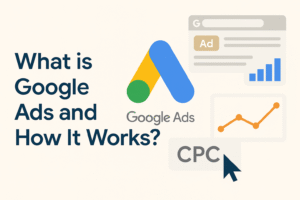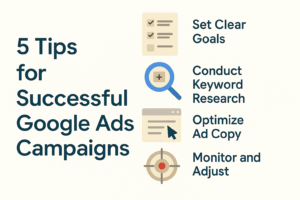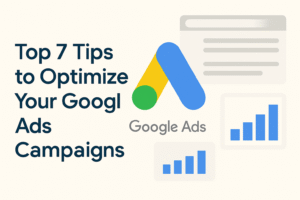Google Ads Guides
Two SEO-friendly articles: fundamentals of Google Ads and seven optimization tips to improve ROI.
What is Google Ads and How It Works?
Google Ads is one of the most powerful online advertising platforms that helps businesses reach potential customers on Google’s search engine and across the web. By targeting specific keywords, demographics, and locations, businesses can increase visibility and drive traffic to their websites.
How Google Ads Works
Google Ads operates on a pay-per-click (PPC) model, meaning advertisers only pay when someone clicks on their ad. The platform uses an auction system where advertisers bid on keywords related to their products or services. Google then decides which ads to show based on bid amount, ad quality, and relevance.
Benefits of Using Google Ads
- Instant visibility – appear on top of Google search results quickly.
- Targeted advertising – reach the right audience by selecting keywords, locations, devices, and demographics.
- Measurable results – track conversions, clicks, and impressions in real time.
- Flexible budgets – control spending with daily limits and campaign adjustments.
Types of Google Ads Campaigns
- Search Ads – text ads on Google search results.
- Display Ads – visual ads on partner websites.
- Video Ads – ads shown on YouTube.
- Shopping Ads – product-based ads with images and prices.
- App Promotion Ads – drive downloads and app engagement.
Google Ads offers businesses a scalable and measurable way to attract new customers. Whether you are a small business or a global brand, running well-optimized campaigns can deliver impressive results.
SEO Keywords: Google Ads, PPC advertising, search engine marketing, online advertising, Google Ads benefits.
Top 7 Tips to Optimize Your Google Ads Campaigns
Running a Google Ads campaign is not just about setting it up—it’s about optimization. Without proper adjustments, you could waste money and miss valuable leads. Here are the top tips to make your campaigns more effective.
1) Choose the Right Keywords
Use keyword research tools to find high-intent, relevant, and cost-effective keywords. Avoid overly broad terms that bring irrelevant clicks.
2) Write Compelling Ad Copy
Your ads should have clear headlines, a strong call to action, and highlight what makes your business unique. Test different ad variations to see what works best.
3) Use Negative Keywords
Adding negative keywords prevents your ads from showing on irrelevant searches, saving money and improving click-through rate (CTR).
4) Optimize Landing Pages
A well-designed landing page with fast loading speed, mobile-friendliness, and clear calls-to-action increases conversions.
5) Track Conversions
Set up conversion tracking in Google Ads or Google Analytics to measure success and identify which keywords or ads drive sales.
6) Adjust Bids and Budgets
Monitor performance and reallocate budget to high-performing keywords while reducing spend on low-performing ones.
7) Use Ad Extensions
Take advantage of sitelinks, call extensions, and location extensions to increase visibility and engagement.
Conclusion
Optimizing your Google Ads campaigns requires continuous testing and improvements. By following these strategies, you can reduce wasted spend and maximize return on investment (ROI).
SEO Keywords: Google Ads optimization, PPC tips, improve Google Ads, online marketing, digital advertising strategies.




